The South of India is home for about 400 Mill People. The states Mumbai, Maharashtra, Goa, Andra Pradesh, Kerala, Tamil Nadu and Karnataka belong to it. The people follow 5 religions, 6 languages are beeing spoken. The country shows overhelming nature close to fascinating rests of more than thousand year old culture.
This time I wanted to see the temples and ruins in Karnataka that have been erected partly before the muslim influence got intensive.
Reached Bangalore I stayed
a night in Taj Westend Hotel not too far from the very modern Center of the eight Mill inhabitant City; having now seen the most big cities in India I can say, that Bangalore seems to be the cleanest Indian City I visited ever.. In the Shopping mall You might even discover a H+M shop.
Because of the heighst (1000m above seelevel) the climate at this time shows nice 23 degrees ; the Taj Westend is a beautiful traditional hotel with perfect comfort situated in a huge garden complex founded in 1830 as a 10 bed guest house; .
you can already see the old building; next morning was time enough for a nice SPA; I would have liked to stay some days, but my plans were different.
Day 1 :
In the afternoon we got the introduction for our next Hotel, a train for 7 days; we were to leave in the evening. The Golden Chariot is a Hotel Train with 16 coaches including restaurants and nice cabins with bathroom for about 40 People. On this trip it runs 7 days from Bangalore via Mysore, Hampi to Goa stopping at some very ancient places from more than thousand years ago and then back to BangaluruThe Train is moving in the evening or night and during daytime the tourists do excursions with a bus. Those are the impressive historical places we planned to vistit: Mysore Palace, Kabini wildlife resort, Srirangapatna, Daria Daulat Bagh, Gumbaz, the jain statue Shravanabelagola, Halebidu und Belur, Hampi Temple complex, Pattakadal and Badami and then Old Goa. After a nice Indian dinner, a glass of red Indian wine from Maharshtra and with the ruttling noise of the train in the ear I fall asleep.
Day 2 :
Next morning we arrived in Mysore, nice breakfast in the Train and afterwords visited Mysore Palace.
This king has had Mysore Palace beeing rebuild and renovated in late 1890. Originally it was first build in 14th century. Still the Family of the Wodeyars are living in one part of the building. Though from architectual stand of view it is not so special für that time there are many nice paintings inside showing parades and the official life of that days. And another speciality is, that all faces on the paintings have been made after real photographs.
After that the bus took as to the Nagarhole national Park, Kabini Resort. In former days ist was a private hunting reserve for the Maharaja of Mysore. Wild elephants, tigers, leopards, jaguars and plenty of deer do live here. Of course they are shy and not easy to be spotted.
We started on a jeep tour and my hope to see anything dropped down, when I saw several cars together. But the reserve is huge and each jeep went another way.
 open jeeps open jeeps |
monkey
After that we made our way back to Mysore, reached there in the afternoon to visit the summer palace and mausoleum of Tipu Sultan, 1782;
 |
| black marble colums from far away |
 |
| giant tree |
 |
| education includes intense advice in own culture |
Then drove back to the Golden Chariot for rest overnight.
 |
| my bed |
 |
| bathroom |
 |
| Dinner |
 |
| the brave train |
badam - badam
Day 4
We would visit the statue of Bhagavan Gometeshwara.
This place is one of the most important

 Jain pilgrim Centers. India ist full of storys and myths. The legend tells us, that 6oo yrs bC the holy Bhadrabahu hungered himself to death to get divine enlightenment to rescue his people that had fleed from drought in Ujjain. In the remembering of that several temples have been built in the Region. In the 10th centuary a huge statue, 17 meters tall, was build as a symbol of askesis on the top of a hill. You should get up early (don ´t forget Your water! I would not recommend the tour in european summer!) to make the way with ~ 620 steps up to the top. The later the morning an always longer procession of people is on the way.
Jain pilgrim Centers. India ist full of storys and myths. The legend tells us, that 6oo yrs bC the holy Bhadrabahu hungered himself to death to get divine enlightenment to rescue his people that had fleed from drought in Ujjain. In the remembering of that several temples have been built in the Region. In the 10th centuary a huge statue, 17 meters tall, was build as a symbol of askesis on the top of a hill. You should get up early (don ´t forget Your water! I would not recommend the tour in european summer!) to make the way with ~ 620 steps up to the top. The later the morning an always longer procession of people is on the way.
In the afternoon we visited Halebidu and Belur.
Helebidu was in th 12th century the capital of the Hoysala; as for more temples and palaces of that time we already know the name of the builder, Vishnuvardana. In later years just the names of the kings stayed public. The temple is famous of its wealth of sculptural details; its is covered with countless variety of depictions from Hindu mythology. The temple ist guarded by a huge Nandy Bull.
This is the Nandi; it was the mount for God Shiva. The Story is, that he was a little stupid. One day Shiva asked him, how the people were doing on earth. Nandy told him ,they were
quarreling and even fighting a lot. So Shiva got angry about and wanted a change. He told Nandi to go down to the people and tell the poeople from now on they should held service two times a day and eat one time so there would be now time for fighting. Nandi went down to earth and called the people together . But unfortunately he had forgotten what Shiva had said. So Nandi told the People they should eat 3 times a day and pray one time. That is how it stayed to be.
Some pictures from Indian daily life.
Day 5
Staying in Hospet we visited Hampi. It is situated in a huge field of giant granit blocks. To day named Hampi - in former days Vijayanagar, was the capital of the last Hindu Empire bevor the arrival of the muslim emperors. In 1450 this empire reached from Gulbarga in the North to the bottom of the Indien coast in the South, and from the Malabar coast which is now GOA to Orissa in the East. Travellers of that time described a bloomimg City, looking as big as Rome, fruit trees in the yards as Mango, bethelnut, Lemon- and orange trees;
the streets were full of people and elephants .
Nowadays the ruins of temples and and palaces are spreed around in 26 squarekilometers. To see most places and really feel the athmosphere you would need some more days. Beside the unique buildings you can view pilgrims and sadhus washing there colourfull clothes in the Tungabhadra-river and with the ringling of the temple bells and the magic of the evening light you might feel how it looked like in ancient days. We started in Hampi Bazaar and visited the Virupaksha temple.
 they put pieces of wood in Little cuts along a line and watered them; th wood swall and jumped of the granit
they put pieces of wood in Little cuts along a line and watered them; th wood swall and jumped of the granit
Day 4
We would visit the statue of Bhagavan Gometeshwara.
 |
| shoes mostly have to be undressed before entering spiritual localisations |

 Jain pilgrim Centers. India ist full of storys and myths. The legend tells us, that 6oo yrs bC the holy Bhadrabahu hungered himself to death to get divine enlightenment to rescue his people that had fleed from drought in Ujjain. In the remembering of that several temples have been built in the Region. In the 10th centuary a huge statue, 17 meters tall, was build as a symbol of askesis on the top of a hill. You should get up early (don ´t forget Your water! I would not recommend the tour in european summer!) to make the way with ~ 620 steps up to the top. The later the morning an always longer procession of people is on the way.
Jain pilgrim Centers. India ist full of storys and myths. The legend tells us, that 6oo yrs bC the holy Bhadrabahu hungered himself to death to get divine enlightenment to rescue his people that had fleed from drought in Ujjain. In the remembering of that several temples have been built in the Region. In the 10th centuary a huge statue, 17 meters tall, was build as a symbol of askesis on the top of a hill. You should get up early (don ´t forget Your water! I would not recommend the tour in european summer!) to make the way with ~ 620 steps up to the top. The later the morning an always longer procession of people is on the way. |
| half the way made |
 |
| but there are even more steps to be made |
 |
| on the top - the statue is seated in a small Patio - first entrance |
 |
| .. the past, these reliefs are ~ 1400 years old |
 |
| temple built into the rocks |
 |
| Bhagavan Gomateshwara - looking - resting and ... |
 |
| praying, - monks and pilgrims |
 |
| - is close together |
 |
| at the moment the statue is under rennovation - but not at all less empressing |
 |
| how did they get the stone so smooth? |
 |
| the view from the top - there are countless other temples in the surrounding |
 |
| back to the bottom You can get coconut water as refreshment |
In the afternoon we visited Halebidu and Belur.
Helebidu was in th 12th century the capital of the Hoysala; as for more temples and palaces of that time we already know the name of the builder, Vishnuvardana. In later years just the names of the kings stayed public. The temple is famous of its wealth of sculptural details; its is covered with countless variety of depictions from Hindu mythology. The temple ist guarded by a huge Nandy Bull.
 |
| this is Ganesha - my favourite |
This is the Nandi; it was the mount for God Shiva. The Story is, that he was a little stupid. One day Shiva asked him, how the people were doing on earth. Nandy told him ,they were
quarreling and even fighting a lot. So Shiva got angry about and wanted a change. He told Nandi to go down to the people and tell the poeople from now on they should held service two times a day and eat one time so there would be now time for fighting. Nandi went down to earth and called the people together . But unfortunately he had forgotten what Shiva had said. So Nandi told the People they should eat 3 times a day and pray one time. That is how it stayed to be.
Some pictures from Indian daily life.
Day 5
Staying in Hospet we visited Hampi. It is situated in a huge field of giant granit blocks. To day named Hampi - in former days Vijayanagar, was the capital of the last Hindu Empire bevor the arrival of the muslim emperors. In 1450 this empire reached from Gulbarga in the North to the bottom of the Indien coast in the South, and from the Malabar coast which is now GOA to Orissa in the East. Travellers of that time described a bloomimg City, looking as big as Rome, fruit trees in the yards as Mango, bethelnut, Lemon- and orange trees;
the streets were full of people and elephants .
Nowadays the ruins of temples and and palaces are spreed around in 26 squarekilometers. To see most places and really feel the athmosphere you would need some more days. Beside the unique buildings you can view pilgrims and sadhus washing there colourfull clothes in the Tungabhadra-river and with the ringling of the temple bells and the magic of the evening light you might feel how it looked like in ancient days. We started in Hampi Bazaar and visited the Virupaksha temple.
 they put pieces of wood in Little cuts along a line and watered them; th wood swall and jumped of the granit
they put pieces of wood in Little cuts along a line and watered them; th wood swall and jumped of the granit
the old bazar
 |
| a long allee of the rests |
and the Vittala Swami Temple
 the musical pillars- there are plenty of groups of them and each has got a different sound the musical pillars- there are plenty of groups of them and each has got a different sound |
the past -
 |
| and today |
 |
| mais is beeing dried |
Tungabhadra river shores in the evening
 |
| ..like the Holy Family |
For me it was the most beautiful temples during the journey, it touched me really
..she seemed to be sceptical.
 |
| even 30 ° C are not warm enough for this little one |
 |
| in the train station |
we left for GOA were we reached before midnight
DAY 7
GOA is Indias smallest state, but the richest. Tourists love to com e here because of the nice beaches and the easy way of life. They sometimes forget to respect the Indian culture.
GOA was Portugese for 450 years till 1961. In 1600 it was a huge cita with about 300.000 inhabitants, rich from trading with horses, silk, spices and jewels. About 1000 ships reached the harbour every year.. Panajis ist the capitol nowadays. Both, Old Goa and Panaji do have nice old town parts worth to see and some nice churches
 |
| The holy Church of Franz of Assisi |
 |
| Christian missionarity |
 |
| a bird |
For me this was the end of the journey; I left the train in Goa .
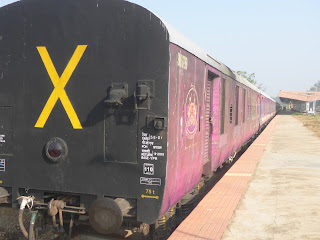 In one week I got much input about the history; I felt always very comfortable and got to know some nice interesting people.
In one week I got much input about the history; I felt always very comfortable and got to know some nice interesting people.




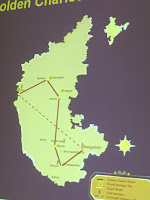















 praying and dancing -
praying and dancing - 






























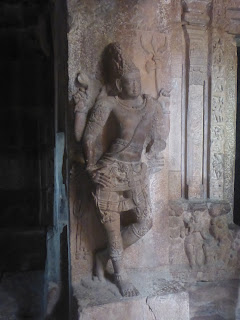




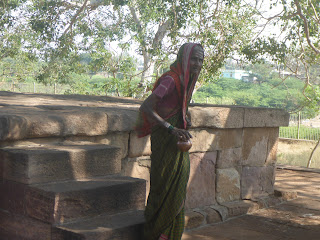




 nice wall painting
nice wall painting




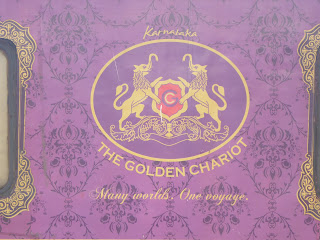 a nice home for one week
a nice home for one week